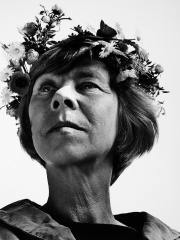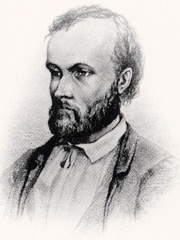







The Most Famous
WRITERS from Finland
Top 10
The following people are considered by Pantheon to be the top 10 most legendary Finnish Writers of all time. This list of famous Finnish Writers is sorted by HPI (Historical Popularity Index), a metric that aggregates information on a biography's online popularity. Visit the rankings page to view the entire list of Finnish Writers.

1. Tove Jansson (1914 - 2001)
With an HPI of 78.49, Tove Jansson is the most famous Finnish Writer. Her biography has been translated into 71 different languages on wikipedia.
Tove Marika Jansson (Finland Swedish: [ˈtuːve ˈjɑːnsːon] ; 9 August 1914 – 27 June 2001) was a Swedish-speaking Finnish author, novelist, painter, illustrator and comic strip author. Brought up by artistic parents, Jansson studied art from 1930 to 1938 in Helsinki, Stockholm, and Paris. She held her first solo art exhibition in 1943. Over the same period, she penned short stories and articles for publication, and subsequently drew illustrations for book covers, advertisements, and postcards. She continued her work as an artist and writer for the rest of her life. Jansson wrote the Moomin novel series for children, starting with the 1945 The Moomins and the Great Flood. The following two books, Comet in Moominland and Finn Family Moomintroll, published in 1946 and 1948 respectively, were highly successful, and sales of the first book increased correspondingly. For her work as a children's author she received the Hans Christian Andersen Medal in 1966; among her many later awards was the Selma Lagerlöf Prize in 1992. Her Moomin stories have been adapted for the theatre, the cinema, and as an opera. She held a solo exhibition of paintings in 1955, and five more between 1960 and 1970. She carried out several commissions for murals in public buildings around Finland between 1945 and 1984. She created the illustrations both for her own books and for classics including Alice's Adventures in Wonderland and The Hobbit. Starting with the semi-autobiographical Bildhuggarens dotter (Sculptor's Daughter) in 1968, Jansson wrote six novels, including the admired Sommarboken (The Summer Book), and five short story collections for adults.

2. Frans Eemil Sillanpää (1888 - 1964)
With an HPI of 75.78, Frans Eemil Sillanpää is the 2nd most famous Finnish Writer. His biography has been translated into 77 different languages.
Frans Eemil Sillanpää (pronounced [frɑns ˈeːmil ˈsilːɑmˌpæː] ; 16 September 1888 – 3 June 1964) was a Finnish writer. In 1939, he became the first Finnish writer to be awarded the Nobel Prize for Literature "for his deep understanding of his country's peasantry and the exquisite art with which he has portrayed their way of life and their relationship with Nature".

3. Mika Waltari (1908 - 1979)
With an HPI of 72.59, Mika Waltari is the 3rd most famous Finnish Writer. His biography has been translated into 47 different languages.
Mika Toimi Waltari (pronounced [ˈmikɑ ˈʋɑltɑri] ; 19 September 1908 – 26 August 1979) was a Finnish writer, best known for his best-selling novel The Egyptian (Finnish: Sinuhe egyptiläinen). He was extremely productive. Besides his novels he also wrote poetry, short stories, crime novels, plays, essays, travel stories, film scripts, and rhymed texts for comic strips by Asmo Alho.

4. Mikael Agricola (1510 - 1557)
With an HPI of 71.16, Mikael Agricola is the 4th most famous Finnish Writer. His biography has been translated into 53 different languages.
Mikael Agricola (Finnish: [ˈmikɑel ˈɑɡrikolɑ] ; c. 1510 – 9 April 1557) was a Finnish Lutheran clergyman who became the de facto founder of literary Finnish and a prominent proponent of the Protestant Reformation in Sweden, including Finland, which was a Swedish territory at the time. He is often called the "father of literary Finnish". Agricola was consecrated as the bishop of Turku (Åbo) in 1554, without papal approval. He continued the reform of the Finnish church (then a part of the Church of Sweden) along Lutheran lines. He translated the New Testament into Finnish and also produced the prayer book and hymns used in Finland's new Lutheran Church. This work set the rules of orthography that are the basis of modern Finnish spelling. His thorough work is particularly remarkable in that he accomplished it in only three years. He died of sudden illness while returning from a trip during which he assisted in negotiating the Treaty of Novgorod with the Tsardom of Russia.

5. Arto Paasilinna (1942 - 2018)
With an HPI of 70.00, Arto Paasilinna is the 5th most famous Finnish Writer. His biography has been translated into 41 different languages.
Arto Tapio Paasilinna (Finnish: [ˈɑrto ˈpɑːsiˌlinːɑ], approximately AR-toh PAH-see-LIN-nah; 20 April 1942 – 15 October 2018) was a Finnish writer, being a former journalist turned comic novelist. One of Finland's most successful novelists, he won a broad readership outside of Finland in a way few other Finnish authors have before. Translated into 27 languages, over seven million copies of his books have been sold worldwide, and he has been claimed as "instrumental in generating the current level of interest in books from Finland". Paasilinna is mostly known for his 1975 novel The Year of the Hare (Jäniksen vuosi), a bestseller in France and Finland, translated into 18 languages, awarded three international prizes, and adapted twice into feature films: a 1977 Finnish film directed by Risto Jarva called The Year of the Hare, and a 2006 French film directed by Marc Rivière called Le Lièvre de Vatanen. Arto Paasilinna's brothers are the writers Erno Paasilinna, Reino Paasilinna and Mauri Paasilinna.

6. Johan Ludvig Runeberg (1804 - 1877)
With an HPI of 68.50, Johan Ludvig Runeberg is the 6th most famous Finnish Writer. His biography has been translated into 45 different languages.
Johan Ludvig Runeberg (Finland Swedish: [ˈjuːhɑn ˈlʉdːviɡ ˈrʉːnebærj]; 5 February 1804 – 6 May 1877) was a Finnish priest, lyric and epic poet. He wrote exclusively in Swedish. He is considered a national poet of Finland. He is the author of the lyrics to Vårt land (Our Land, Maamme in Finnish) which became the Finnish national anthem. Runeberg was also involved in the modernization of the Finnish Lutheran hymnal and produced many texts for the new edition.

7. Aleksis Kivi (1834 - 1872)
With an HPI of 67.41, Aleksis Kivi is the 7th most famous Finnish Writer. His biography has been translated into 51 different languages.
Aleksis Kivi (Finnish pronunciation: [ˈɑleksis ˈkiʋi] ; born Alexis Stenvall; 10 October 1834 – 31 December 1872) was a Finnish writer who wrote the first significant novel in the Finnish language, Seitsemän veljestä (Seven Brothers), published in 1870. He is also known for his 1864 play, Nummisuutarit (Heath Cobblers). Although Kivi was among the very earliest writers of prose and lyrics in Finnish, he is still considered one of the greatest. Kivi is regarded as the national writer of Finland and his birthday, 10 October, is celebrated as Finnish Literature Day.

8. Zachris Topelius (1818 - 1898)
With an HPI of 67.01, Zachris Topelius is the 8th most famous Finnish Writer. His biography has been translated into 34 different languages.
Zacharias Topelius (Finland Swedish pronunciation: [sɑˈkɑːriɑs toˈpeːliʉs]; 14 January 1818 – 12 March 1898) was a Finnish author, poet, journalist, historian, and rector of the University of Helsinki who wrote novels related to Finnish history. He wrote his works exclusively in Swedish, although they were translated early on into Finnish.

9. Eino Leino (1878 - 1926)
With an HPI of 64.54, Eino Leino is the 9th most famous Finnish Writer. His biography has been translated into 45 different languages.
Eino Leino (born Armas Einar Leopold Lönnbohm; 6 July 1878 – 10 January 1926) was a Finnish poet and journalist who is considered one of the pioneers of Finnish poetry and a national poet of Finland. His poems combine modern and Finnish folk elements. Much of his work is in the style of the Kalevala and folk songs in general. Nature, love, and despair are frequent themes in Leino's work. He is beloved and widely read in Finland today. Leino's birthday on 6 July was named Eino Leino Day (Eino Leinon päivä) as well as day of Finnish poetry and summer in 1992, and it is an established Finnish flag day.

10. Väinö Linna (1920 - 1992)
With an HPI of 64.33, Väinö Linna is the 10th most famous Finnish Writer. His biography has been translated into 40 different languages.
Väinö Valtteri Linna (pronounced [ˈʋæi̯nø ˈlinːɑ] ; 20 December 1920 – 21 April 1992) was a Finnish author and a former soldier who fought in the Continuation War (1941–44). Linna gained literary fame with his third novel, Tuntematon sotilas (The Unknown Soldier, published in 1954), and consolidated his position with the trilogy Täällä Pohjantähden alla (Under the North Star, published in 1959–1963 and translated into English by Richard Impola). Both have been adapted to a film format on several occasions; The Unknown Soldier was first adapted into a film in 1955 and Under the North Star in 1968 as Here, Beneath the North Star, both directed by Edvin Laine.
People
Pantheon has 45 people classified as Finnish writers born between 1510 and 1980. Of these 45, 16 (35.56%) of them are still alive today. The most famous living Finnish writers include Sofi Oksanen, Rosa Liksom, and Tua Forsström. The most famous deceased Finnish writers include Tove Jansson, Frans Eemil Sillanpää, and Mika Waltari. As of April 2024, 1 new Finnish writers have been added to Pantheon including Jessikka Aro.
Living Finnish Writers
Go to all RankingsSofi Oksanen
1977 - Present
HPI: 57.50
Rosa Liksom
1958 - Present
HPI: 56.07
Tua Forsström
1947 - Present
HPI: 55.98
Märta Tikkanen
1935 - Present
HPI: 55.74
Antti Tuuri
1944 - Present
HPI: 55.37
Kjell Westö
1961 - Present
HPI: 55.21
Hannu Salama
1936 - Present
HPI: 53.71
Leena Krohn
1947 - Present
HPI: 53.55
Monika Fagerholm
1961 - Present
HPI: 52.00
Kari Hotakainen
1957 - Present
HPI: 51.85
Sam Lake
1970 - Present
HPI: 51.74
Johanna Sinisalo
1958 - Present
HPI: 48.85
Deceased Finnish Writers
Go to all RankingsTove Jansson
1914 - 2001
HPI: 78.49
Frans Eemil Sillanpää
1888 - 1964
HPI: 75.78
Mika Waltari
1908 - 1979
HPI: 72.59
Mikael Agricola
1510 - 1557
HPI: 71.16
Arto Paasilinna
1942 - 2018
HPI: 70.00
Johan Ludvig Runeberg
1804 - 1877
HPI: 68.50
Aleksis Kivi
1834 - 1872
HPI: 67.41
Zachris Topelius
1818 - 1898
HPI: 67.01
Eino Leino
1878 - 1926
HPI: 64.54
Väinö Linna
1920 - 1992
HPI: 64.33
Minna Canth
1844 - 1897
HPI: 64.12
Juhani Aho
1861 - 1921
HPI: 63.55
Newly Added Finnish Writers (2025)
Go to all RankingsOverlapping Lives
Which Writers were alive at the same time? This visualization shows the lifespans of the 25 most globally memorable Writers since 1700.
















